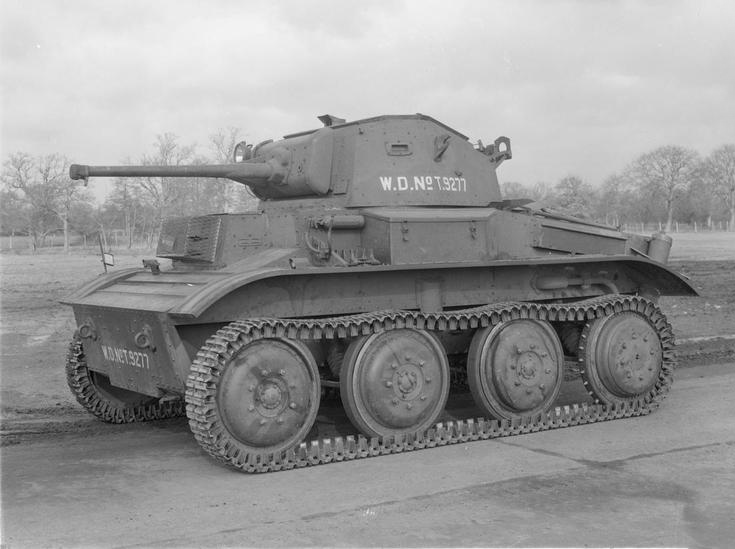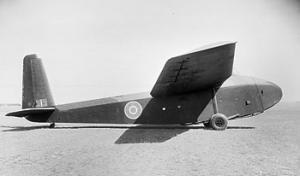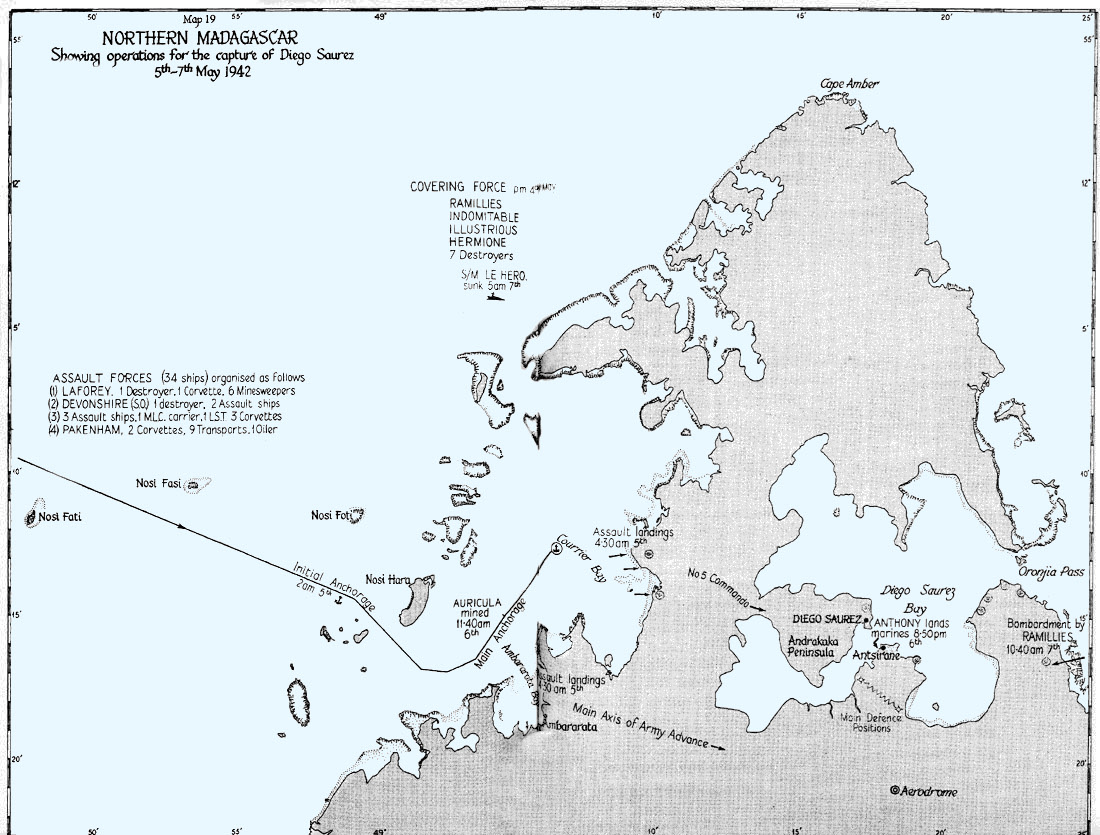|
Tetrarch (tank)
The Light Tank Mk VII (A17), also known as the Tetrarch, was a British light tank produced by Vickers-Armstrongs in the late 1930s and used during the Second World War. The Tetrarch was the latest in the line of light tanks built by the company for the British Army. It improved upon its predecessor, the Light Tank Mk VIC, by introducing the extra firepower of a 2-pounder gun. The War Office ordered 70 tanks, an order that eventually increased to 220. Production was delayed by several factors and only 100 to 177 of the tanks were produced.Tucker (p. 90) states that 177 of the Mk VIIs were built during the war, but Flint (p. 12) states that whilst this figure is given in most published sources, surviving War Office documentation gives a lower figure of 100, putting the final tally somewhere between these two figures. The design flaws of the tank, combined with the decision by the War Office not to use light tanks in British armoured divisions, ruled out the use of Tetrarchs in ... [...More Info...] [...Related Items...] OR: [Wikipedia] [Google] [Baidu] |
Tetrarch - Light Tank Mark VII
Tetrarch, Tetrarchs, or Tetrarchy may refer to: * Tetrarchy, the four co-emperors of the Roman Empire instituted by the Emperor Diocletian * Portrait of the Four Tetrarchs - a sculpture of the four co-emperors of the Roman Empire * Herodian Tetrarchy, formed by the sons of Herod the Great * Tetrarch, Military rank#Greek ranks in ancient Greek armies * ''Tetrarch'' (novel), a 2003 novel by Ian Irvine * Light Tank Mk VII Tetrarch, a British light tank of World War II * The Tetrarch, a Thoroughbred racehorse * The Tetrarchs of Ancient Thessaly under Philip II of Macedon * The Tetrarchs of Galatia in Asia Minor * Tetrarches, a rank in the Byzantine army * ''Tetrarch'', a 1981 fantasy novel by Alex Comfort * Tetrarch (band), a nu metal band from Atlanta, Georgia * Tetrarchy, a subdivision of the Royal Phalanx in 19th-century Greece * HMS ''Tetrarch'' is the name of the two vessels that have served in the Royal Navy See also * Tetricus (other), 3rd century rulers of the Gall ... [...More Info...] [...Related Items...] OR: [Wikipedia] [Google] [Baidu] |
Alecto (SPG)
The Alecto, initially known as the Harry Hopkins Mk 1 CS, was a self propelled gun developed by the British during World War II. Development In 1942 a project for a 3.75 inch (95 mm) howitzer was started. Two guns were made, and one of these was chosen for test mounting on a Light Tank Mk VIII The Tank, Light, Mk VIII (A25), also known as the Harry Hopkins, after American President Roosevelt's chief diplomatic advisor, was a British light tank produced by Vickers-Armstrong during the Second World War. The Mk VIII was the last in the l ... "Harry Hopkins" chassis. Like the Harry Hopkins, the Alecto had skid steering, which operated by bowing the tracks through lateral movements of the central road wheels. The gun was mounted in an open-topped structure. The first trials were not started until late in 1944. The trials uncovered various problems but by the time these were solved the war in Europe was over. With little perceived potential for use in the war against J ... [...More Info...] [...Related Items...] OR: [Wikipedia] [Google] [Baidu] |
Cromwell Tank
The Cromwell tank, officially Tank, Cruiser, Mk VIII, Cromwell (A27M), was one of the series of cruiser tanks fielded by Britain in the Second World War. Named after the English Civil War-era military leader Oliver Cromwell, the Cromwell was the first tank put into service by the British to combine high speed from a powerful, reliable engine (the Rolls-Royce Meteor) and reasonable vehicle armour, armour. The intended dual-purpose high velocity gun could not be fitted in the turret, so a medium velocity dual purpose gun was fitted instead. Further development of the Cromwell combined with a high velocity gun led to the Comet tank. The name "Cromwell" was initially applied to three vehicles during development. Early Cromwell development led to the creation of the Cavalier tank, A24 Cavalier. Later Cromwell development led to the creation of the competing Tank, Cruiser, Mk VIII, Centaur (A27L) design. The Centaur tank was closely related to the Cromwell, both vehicles being externa ... [...More Info...] [...Related Items...] OR: [Wikipedia] [Google] [Baidu] |
Operation Tonga
Operation Tonga was the codename given to the airborne operation undertaken by the British 6th Airborne Division between 5 June and 7 June 1944 as a part of Operation Overlord and the D-Day landings during World War II. The paratroopers and glider-borne airborne troops of the division, commanded by Major-General Richard Nelson Gale, landed on the eastern flank of the invasion area, near to the city of Caen, tasked with a number of objectives. The division was to capture two strategically important bridges over the Caen Canal and Orne River which were to be used by Allied ground forces to advance once the seaborne landings had taken place, destroy several other bridges to deny their use to the Germans and secure several important villages. The division was also assigned the task of assaulting and destroying the Merville Gun Battery, an artillery battery that Allied intelligence believed housed a number of heavy artillery pieces, which could bombard the nearest invasion beach ... [...More Info...] [...Related Items...] OR: [Wikipedia] [Google] [Baidu] |
6th Airborne Division (United Kingdom)
The 6th Airborne Division was an airborne infantry division of the British Army during the Second World War. Despite its name, the 6th was actually the second of two airborne divisions raised by the British Army during the war, the other being the 1st Airborne Division. The 6th Airborne Division was formed in the Second World War, in mid-1943, and was commanded by Major-General Richard N. Gale. The division consisted of the 3rd and 5th Parachute Brigades along with the 6th Airlanding Brigade and supporting units. The division's first mission was Operation Tonga on 6 June 1944, D-Day, part of the Normandy landings, where it was responsible for securing the left flank of the Allied invasion during Operation Overlord. The division remained in Normandy for three months before being withdrawn in September. The division was entrained day after day later that month, over nearly a week, preparing to join Operation Market Garden but was eventually stood down. While still recruiti ... [...More Info...] [...Related Items...] OR: [Wikipedia] [Google] [Baidu] |
Allied Invasion Of Sicily
The Allied invasion of Sicily, also known as Operation Husky, was a major campaign of World War II in which the Allied forces invaded the island of Sicily in July 1943 and took it from the Axis powers ( Fascist Italy and Nazi Germany). It began with a large amphibious and airborne operation, followed by a six-week land campaign, and initiated the Italian campaign. To divert some of the Axis forces to other areas, the Allies engaged in several deception operations, the most famous and successful of which was Operation Mincemeat. Husky began on the night of 9–10 July 1943 and ended on 17 August. Strategically, Husky achieved the goals set out for it by Allied planners; the Allies drove Axis air, land and naval forces from the island and the Mediterranean sea lanes were opened for Allied merchant ships for the first time since 1941. These events led to the Italian leader, Benito Mussolini, being toppled from power in Italy on 25 July, and to the Allied invasion of Italy on 3 ... [...More Info...] [...Related Items...] OR: [Wikipedia] [Google] [Baidu] |
M22 Locust
The M22 Locust, officially Light Tank (Airborne), M22, was an American-designed airborne light tank which was produced during World War II. The Locust began development in 1941 after the British War Office requested that the American government design a purpose-built airborne light tank which could be transported by glider into battle to support British airborne forces. The War Office had originally selected the Light Tank Mark VII Tetrarch light tank for use by the airborne forces, but it had not been designed with that exact purpose in mind so the War Office believed that a purpose-built tank would be required to replace it. The United States Army Ordnance Department was asked to produce this replacement, which in turn selected Marmon-Herrington to design and build a prototype airborne tank in May 1941. The prototype was designated the Light Tank T9 (Airborne), and was designed so that it could be transported underneath a Douglas C-54 Skymaster transport aircraft, although its d ... [...More Info...] [...Related Items...] OR: [Wikipedia] [Google] [Baidu] |
General Aircraft Hamilcar
The General Aircraft Limited GAL. 49 Hamilcar or Hamilcar Mark I was a large British military glider produced during the Second World War, which was designed to carry heavy cargo, such as the Tetrarch or M22 Locust light tank. When the British airborne establishment was formed in 1940 by the order of Prime Minister Winston Churchill it was decided to develop a large glider which would be able to transport heavy equipment in support of airborne troops. General Aircraft Limited were chosen in January 1941 to develop this glider, which they designated the GAL. 49 'Hamilcar'. It was designed to transport a light tank or two Universal Carriers. A number of problems, which included vacillation by the War Office on the number of gliders it wanted and poor management by GAL, led to delays in the production of the Hamilcar and it was not until mid-1943 that the first production glider was assembled. These problems were only partially solved and production of the glider continued to be ... [...More Info...] [...Related Items...] OR: [Wikipedia] [Google] [Baidu] |
Airborne Forces
Airborne forces, airborne troops, or airborne infantry are ground combat units carried by aircraft and airdropped into battle zones, typically by parachute drop or air assault. Parachute-qualified infantry and support personnel serving in airborne units are also known as paratroopers. The main advantage of airborne forces is their ability to be deployed into combat zones without land passage, as long as the airspace is accessible. Formations of airborne forces are limited only by the number and size of their transport aircraft; a sizeable force can appear "out of the sky" behind enemy lines in merely hours if not minutes, an action known as ''vertical envelopment''. Airborne forces typically lack enough supplies for prolonged combat, so they are utilized for establishing an airhead to bring in larger forces before carrying out other combat objectives. Some infantry fighting vehicles have also been modified for paradropping with infantry to provide heavier firepower. Due t ... [...More Info...] [...Related Items...] OR: [Wikipedia] [Google] [Baidu] |
1st Airborne Division (United Kingdom)
The 1st Airborne Division was an airborne infantry division of the British Army during the Second World War. The division was formed in late 1941 during the Second World War, after the British Prime Minister, Winston Churchill, demanded an airborne force, and was initially under command of Major-General Frederick A. M. Browning. The division was one of two airborne divisions raised by the British Army during the war, with the other being the 6th Airborne Division, created in May 1943, using former units of the 1st Airborne Division. The division's first two missions—Operation Biting, a parachute landing in France, and Operation Freshman, a glider mission in Norway—were both raids. Part of the division was sent to North Africa at the end of 1942, where it fought in the Tunisian Campaign, and when the Allies invaded Sicily in July 1943, the division undertook two brigade sized landings. The first, Operation Ladbroke, carried out by glider infantry of the 1st Airlanding Br ... [...More Info...] [...Related Items...] OR: [Wikipedia] [Google] [Baidu] |
Operation Ironclad
The Battle of Madagascar (5 May – 6 November 1942) was a British campaign to capture the Vichy French-controlled island Madagascar during World War II. The seizure of the island by the British was to deny Madagascar's ports to the Imperial Japanese Navy and to prevent the loss or impairment of the Allied shipping routes to India, Australia and Southeast Asia. It began with Operation Ironclad, the seizure of the port of Diego-Suarez (now Antsiranana) near the northern tip of the island, on 5 May 1942. A subsequent campaign to secure the entire island, Operation Stream Line Jane, was opened on 10 September. The Allies broke into the interior, linking up with forces on the coast and secured the island by the end of October. Fighting ceased and an armistice was granted on 6 November. This was the first large-scale operation by the Allies combining sea, land and air forces. The island was placed under Free French control.Rigge p. 100 Background Geopolitical Diego-Suarez is a l ... [...More Info...] [...Related Items...] OR: [Wikipedia] [Google] [Baidu] |








